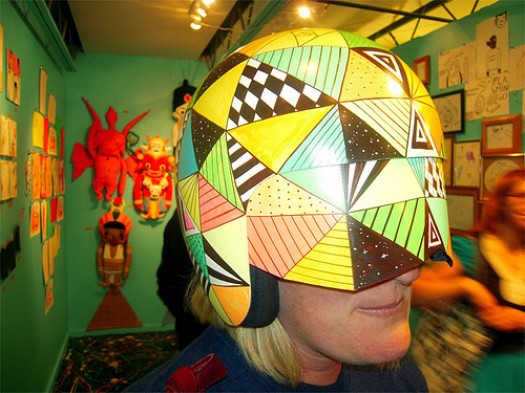I could use one of these right about now. Via these geniuses.
Category: ideas
I've got the killer app for the NBA television-viewing experience, something that will melt faces around the world and provide the league with yet another license to print money. (Props to Justin and Zidane who sparked this idea last night as we watched Game 3.)You could call it: NBA 360, or the Courtside Package, or the Real NBA Courtside 360 Package or whatever, but the concept is simple … Arrange some microphones around/above the court, and create a pay TV service that allows fans to hear the trash talk that accompanies every game. Even better: You could eliminate the announcers, and go au naturel: Game trash talk soundtrack, nothing more.

"I feel so misunderstood, KG. Sometimes I just wish the fans could know the real Kobe." [Photo: Stephen Dunn]
David Stern will never go for it, you say? You may be right — today — but Stern is a product manager at heart. His recent crackdowns may seem moral in nature, but they're really efforts to maintain the integrity of the current NBA brand. Of course, certain brands continually change, and some brands are forced to change. (General Motors can't continue to be known primarily the makers of Suburbans and Hummers forever, for instance). Sometime soon, I expect that Stern will do what all good PMs do: Evolve his product and brand to respond to the market.
Why a trash-talk channel, then?
Well, my guess is that people harbor fewer and fewer illusions about what's happening on the court. It obviously ain't Sunday School, as much as the NBA wants you to believe it is. Also, even the slightest peek at the trash talk is fascinating. The one and only time I sat close to courtside — in Toronto, 2003, end of the season, against the Hornets — I heard Baron Davis and Rafer Alston go at it for a few seconds near the sideline and I was stunned: It was deeply personal, and profoundly entertaining. (It's also unrepeatable on a family-oriented blog like this). Curt Schilling sat courtside during Game 2 of the Finals, and he also was strangely compelled by the trash talk:
… About 43 times last night I heard things being said that would have made me swing at someone. These guys talk MAJOR trash on the floor, and the great part is that most of the times I've seen it the guy on the receiving end usually doesn't respond much, if at all, and just plays the game, schooling the guy who feels like he needs to talk to make his game better.
For example:
Last night KG goes to the line, Lamar Odom (who I became a fan of last night) is saying "Hey KG why don't you help on the ball down here?†Pointing to the paint, and I am guessing he's referencing the fact that KG wasn't down in the paint mixing it up. He says it again, loudly, KG doesn't even acknowledge him, and sinks both. Impressive, total focus.
For the record, I was asking KG the same question from the privacy of my living room.
Anyway, on a philosophical note
For the last 10 or so years, the NBA has been in a sort of conflicted adolescence. Stern makes extreme efforts to manage an outward appearance of normality, but this barely masks the turbulence beneath the surface. He created a dress code, and he enforces strict policies on communication with the media. Meanwhile, everyone associated with the league — fans, players, coaches, etc — knows that this is all window-dressing, and dated window-dressing at that. There is a deeply compelling game within a game going on; why not productize it? There are personalities, feuds, villains, heroes, and so on — why not bring them out, and create a service that people will pay for in the process?
I've followed Khoi Vinh's excellent blog, Subtraction, for a long time. A couple of years ago, he became the Design Director of the New York Times website, and in the meantime the site has really changed, for the better, mostly, I'd say. This week he's doing a Q&A about his work, the NYT, design, and all of that.As I've always been curious about what he does in his role, and the structure of the NYT.com UX department, I was glad to see that someone went there right off the bat:
As the design director, my responsibility is to oversee the creative aspects of these continual improvements. Each one is a project of its own with some range in scope, from very short and discrete to long and drawn out over many months. And each project requires one or more of the members on my team: information architects (who are charged with organizing the features and the flow of information so that people can make use of them most intuitively), design technologists (who do the actual coding of many of these sites, using HTML, CSS, JavaScript, Flash, etc.) and/or visual designers (who handle the overall look and feel, including layout, typography, color, proportion, etc.).You could say that all put together, the final product of our efforts is the user experience, or the sum total of the content and the framework as it's used by visitors to the site. Of course, it's not true that my design group is the only team responsible for creating this experience; it's really the result of contributions across the board, from editors and reporters to project managers and software engineers and many more.

This is a photo by Thomas Allen. I first noticed his stuff when I saw the covers of Vintage reissues of James Ellroy's novels (like this one for Suicide Hill). The photo above is from a series of dioramas that Allen created from cut-outs of 50's pulp novels. I love the use of the book-ends as textured underwater scenery here. Genius. Photo: Foley Gallery.
A lot of what I've been reading seems to resonate with my 9‑to‑5 work. Last night, I was reading architect Witold Rybczynski's account of a shed-building exercise that turns into a much, much more — The Most Beautiful House in the World, and this passage jumped out at me, mostly because it spoke so eloquently of the stuff I value in design work:
The psychologist Bruno Bettelheim once characterized children's play as an activity "characterized by freedom from all but personally imposed rules (which are changed at will), by free-wheeling fantasy involvement, and by absence of any goals outside the activity itself" …
Bettelheim quotes a four year-old who asks, "Is this a fun game or a winning game?" The solitary building game is a fun game–there is no opponent. The concept of fun is elusive and resists easy definition, but it is an undisputed element–perhaps the element–of play. In the present context, it is enough to note that fun does not imply folly or lack of seriousness–quite the opposite … What keeps [the architect] involved for such long periods of time is that the outcome of the design process is unpredictable: it is the result of chance, as in play. He does not know ahead of time exactly what the result will be. He could save himself a lot of time and look for a similar building to reproduce exactly; but this would make as little sense as building the same house of cards again and again, or solving the same crossword puzzle. The issue here is not originality but fun.
The emphasis in that paragraph is mine. This weekend, I was reading a New York Times feature on my man Robert Irwin, and I found myself smiling at this:
A favorite term is "participation." [Irwin] cites, for example, his 1997 transformation of a room that overlooks the Pacific at the La Jolla branch of the San Diego museum. Reasoning that he could not compete with the sweeping view, Mr. Irwin cut three rectangles — squares almost — into the existing windows. "At first I didn't realize the glass was tinted," he said. "So not only did my holes let in air and sound, adding another dimension to the experience, but they made everything seen through them appear in greater focus." You might say he opened the window, that age-old pictorial device, letting in a cool rush of reality.
Once upon a time, I wrote a long post about Irwin's biography, Seeing Is Forgetting the Name of the Thing One Sees by Lawrence Wechsler; when I say that it blew my mind, I mean that the book expanded my mind, made me really think about the way I recognize, interpret and understand the things I see. Finally: Cormac McCarthy. I'm reaching back in time, back to 1994, back to the night I disgustedly flung my copy of All the Pretty Horses out the window of my apartment. (Later that night, I saw the same copy for sale at 16th and Mission BART). Anyway, I'm willing to reconsider my judgment that McCarthy is no more than a smartypants Zane Grey writing for armchair gauchos. The Road stuck with me, really deeply upset me, and I respect that. So I'm giving him another try, and so far, so good: I got a nice copy of The Border Trilogy, and was quickly transported by the prose, though of course I was reminded of Owen Wilson's character Eli Cash, in The Royal Tenanbaums. His book, Old Custer, was written in what he characterized as an "obsolete vernacular," exhibited in this excellent bit:
The crickets and the rust-beetles scuttled among the nettles of the sage thicket. "Vámonos, amigos," he whispered, and threw the busted leather flintcraw over the loose weave of the saddlecock. And they rode on in the friscalating dusklight. [More quotes from the Royal Tenanbaums]
Damn, that's good.
